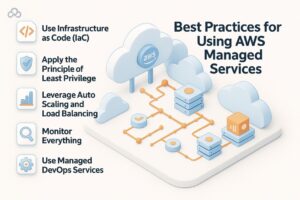Why AWS is the Backbone of Modern Web Development

Building a web application today is no longer a headache. In the digital age of 2025 the users want fast, responsive, always available, and secure apps. Businesses, on the other side, need scalability, efficiency, and low downtime. And that is why many developers and enterprises are switching to AWS managed services to build modern, robust web applications.
Amazon Web Services (AWS) provides an extensive pair of tools and services that help you to create, deploy, and manage applications in the cloud. Whether you’re launching a new product, growing your existing platform, or modernizing legacy systems, AWS managed services has a great solution for every step of your journey.
Let’s explore how you can take best advantage of AWS services for web apps, also understand the right AWS architecture choices, and apply the practices to build future-ready applications.
The AWS Advantage: What Makes It Stand Out
AWS isn’t only the largest cloud provider but also it’s the most versatile one. It offers 200+ services that work together to enhance everything from basic websites to advanced enterprise applications. But it’s just a number (like your age), what truly sets AWS apart is its flexibility, scalability, and focus on innovation.
Unlike traditional hosting, AWS managed services allow you to pay only for what you use and it scales automatically based on demand, and deploy applications globally with minimal effort. You don’t need to worry about managing physical servers such as configuring load balancers, or updating software. Most of such stuff is taken care of by AWS managed services, which handle the backend so you can focus on the important i.e., your product.
Key AWS Services for Modern Web Applications
Let’s break down the core AWS services for web apps that are mostly used by developers and DevOps teams around the globe.
1. Compute Services: EC2, Lambda, and Elastic Beanstalk
When it comes to running your code, AWS provides multiple compute options which depend on your control needs.
Amazon EC2 (Elastic Compute Cloud) allows you to launch virtual servers in just a minute. It is perfect when you need full control over your server configurations. For modern- scalable apps, Auto Scaling Groups and Load Balancers work together to manage traffic without human work.
For serverless applications like- AWS Lambda is a game-changer. It lets you run backend logic without monitoring or managing servers. You can simply upload your code, and Lambda will run it in response to events whether it’s an HTTP request or any file upload.
If you want a managed platform like- Elastic Beanstalk this helps you to use applications quickly using familiar tools like Node.js, Python, Java, and more. It automatically handles scaling, load balancing, and monitoring.
2. Storage and Databases: Amazon S3, RDS, and DynamoDB
Every web application needs to store and retrieve data, whether it’s a user uploads, product data, or logs. AWS provides flexible options here as well.
Amazon S3 is great for storing static files like images, videos, and backups. It’s durable and offers fine-grained security controls. Developers use S3 with CloudFront for fast content service.
For relational data like- Amazon RDS (Relational Database Service) supports MySQL, PostgreSQL, MariaDB, Oracle, and SQL Server. It takes care of patching, backups, and failover, so that you can avoid admin work.
If you’re suffering with unstructured or highly dynamic data, Amazon DynamoDB offers a NoSQL solution with single-digit millisecond latency. It’s great for live apps like gaming, IoT, and social platforms.
Case Study:
The popular language learning platform, Duolingo uses DynamoDB to manage their user progress and preferences. With AWS’s scaling features, the app handles millions of users without bugs.
3. Networking and CDN: CloudFront, Route 53, and VPC
Fast and reliable content delivery is a need. AWS managed services helps you to achieve that through services like Amazon CloudFront, a content delivery network (CDN) that caches content close to your users and reduces latency.
To manage your application’s domain and routing, Amazon Route 53 offers DNS service. Which can route users to the closest location, handle failover scenarios, and connect to health checks.
If you need high control over your networking, you can go for Amazon VPC (Virtual Private Cloud) which allows you to create separate environments and configure security groups, subnets, and access rules.
Building the Right AWS Architecture (Expanded)
Designing the right AWS architecture is the pillar of a high-performing, scalable, and cost-efficient web application. A good architecture not only ensures smooth user experiences but also prepares your application to grow sustainably in the market without rising infrastructure costs.
To begin with, the frontend layer which users directly interact with can be hosted on Amazon S3 when dealing with static websites. S3 provides reliable, low-cost storage for HTML, CSS, JS, and image files. To enhance its performance, Amazon CloudFront, AWS’s Content Delivery Network (CDN), caches content globally and reduces latency by serving it from the nearest location.
Moving to the backend, AWS managed services gives you two amazing options: AWS Lambda and Amazon EC2. If your app needs more control over the environment such as legacy software compatibility, or high computational power, Amazon EC2 with Auto Scaling Groups (ASG) can be great. It allows you to configure virtual machines, run background jobs, and set policies to automatically adjust the compute capacity based on traffic.
Additionally, for automation and faster deployments- a CI/CD pipeline using AWS CodePipeline, CodeBuild, and CodeDeploy can help streamline your development lifecycle. These services allow you to test and deploy code changes smoothly and rollback if needed.
Best Practices for Using AWS Managed Services

Once your AWS environment is live and running, following best practices ensures that it remains efficient, secure, and scalable.
1. Use Infrastructure as Code (IaC)
Managing cloud infrastructure manually is not sustainable anymore. Instead, tools like AWS CloudFormation and Terraform help you define your infrastructure as code. This means every change can be version-controlled, peer-reviewed, and replicated in different environments like development, staging, and production. IaC also reduces human errors and speeds up infrastructure provisioning.
2. Apply the Principle of Least Privilege
AWS Identity and Access Management (IAM) is amazing but must be used correctly. Always follow the least privilege principle that means only granting users and services the permissions they absolutely need and nothing more. This reduces the attack surface and protects sensitive data even if an account is compromised.
3. Leverage Auto Scaling and Load Balancing
If your app traffic varies during the day or across seasons, don’t pay for the unnecessary capacity. Use EC2 Auto Scaling to increase or decrease server instances based on the usage. Pair it with Elastic Load Balancer (ELB) to distribute incoming traffic evenly across instances, reducing downtime or performance dips.
4. Monitor Everything
Without proper analysis, diagnosing issues becomes a nightmare. Amazon CloudWatch helps you to monitor CPU usage, memory, request rates, and more. Set up custom dashboards and alerts to stay on top of potential failures. Additionally, AWS X-Ray track requests end-to-end across microservices helping you debug and improve latency.
5. Use Managed DevOps Services
Building DevOps workflows from ground zero can be time-consuming. Instead, use AWS managed DevOps services like CodePipeline for automating release workflows, CodeBuild for compiling code and running tests, and CodeDeploy for deploying to Lambda, EC2, or on-prem servers. These tools help to improve collaboration between development and operations teams while ensuring faster and more reliable releases.
When to Bring in AWS Consulting Services
AWS managed services is a huge ecosystem with various tools, and it’s easy to feel overwhelmed especially when you’re trying to grow or modernize the legacy systems. And that’s why involving AWS consulting services can be a smart move.
An AWS managed service gives specialized knowledge that helps you to design optimized, scalable, and secure cloud architectures. For startups, they help avoid expensive mistakes in the early-stage of design. For enterprises, they provide strategic insights for large-scale migrations and governance.
Here are scenarios where consulting makes a change:
1. Designing an optimized and secure architecture: Consultants align your system with the AWS Well-Architected Framework to ensure you don’t miss out on best practices.
2. Implementing CI/CD pipelines: They can set up automated build and deployment workflows customized to your development process, using services like CodePipeline and CodeDeploy.
3. Switching legacy apps: Switching from on-premise to cloud isn’t just lift-and-shift. Experts can modernize your codebase and re-architect for cloud-native efficiency.
4. Optimizing cloud costs: Consultants use tools like AWS Cost Explorer and Trusted Advisor to analyze spend and recommend rightsizing or pricing plans like Reserved Instances and Savings Plans.
5. Setting up multi-region failover: Consultants can help design fault-tolerant setups across AWS regions for critical apps which improve recovery readiness and global availability.
Conclusion: Embrace the Future with AWS Managed Services
Building a modern web application is no longer about worrying about software updates. With AWS managed services, you can automate operations, improve performance, and deliver a smooth user experience without burning your budget.
And with the right architecture, best practices, and expert help through AWS consulting services, your application is ready for whatever the future brings.
So, if you’re looking to create secure, fast apps, AWS managed services isn’t just a choice, it’s a competitive advantage.
Do you like to read more educational content? Read our blogs at Cloudastra Technologies or contact us for business enquiry at Cloudastra Contact Us